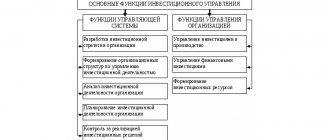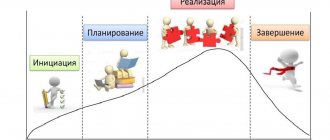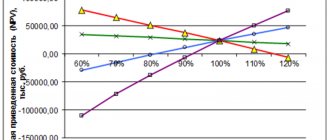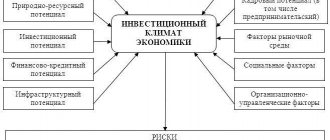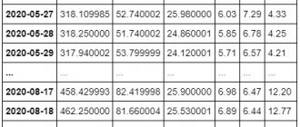Investment management is a set of methods, techniques and principles that allow you to effectively manage the processes of investment and cash flow in order to obtain a stable income. It acts as an integral part of general management.
Management activities that are directly related to investment processes are carried out at several hierarchical levels. If we remember micro- and macroeconomics, we can easily list them. We are talking about states, federal subjects, municipalities and individual enterprises.
It is quite natural that at each of the listed levels, investment activity has its own specifics and features. However, such management, regardless of where it is carried out, is based on the same principles and methods, and also solves similar problems.
Investment activity management
Management is the coordination of several parts of a single whole to achieve a designated goal. Large production consists of a large number of related departments with varying degrees of responsibility and ways of interacting with each other.
Investment activity management is a procedure that allows you to most effectively organize the processes of decision-making, searching for sources of financing and implementing investment projects at the enterprise. It is the organization of interaction between all divisions of the company that is one of the main keys to successful investments. We are talking about the financial, technical and managerial level.
- continuous nature
- the ability to adjust decisions made after the launch of the project/start of investment
- unlimited use of investment instruments if they are able to solve the problem.
Investment management mechanisms
The investment activity management process is based on a certain mechanism. The investment management mechanism is a system of basic elements that regulate the process of developing and implementing investment decisions of an enterprise. The structure of the investment management mechanism includes the following elements:
Market mechanism for regulating the investment activity of an enterprise. This mechanism is formed, first of all, in the sphere of the investment market (primarily the securities market), as well as the commodity market (primarily the market for means of production, objects of labor and finished products) in the context of their individual segments. Supply and demand in these markets determine the level of prices and quotations for individual capital goods and financial instruments, determine the effectiveness of using individual investment instruments, and identify the average rate of return on investments and the average market level of investment risk. As market relations deepen, the role of the market mechanism for regulating the investment activities of enterprises will increase.
State legal regulation of the investment activities of an enterprise. The complexity and versatility of the activities of enterprises in this area in the context of the transition to a market economy determine the need for state regulation. As international experience shows, such multifaceted government regulation is carried out in all countries with developed market economies, without conflicting with the broad independence of enterprises in choosing directions and forms of investment. Characterizing the existing base of state regulations in the field of regulation of enterprise activities in this area, it should be noted that it is far from complete and requires further development.
Internal mechanism for regulating certain aspects of an enterprise's investment activities. The mechanism of such regulation is formed within the enterprise itself, accordingly regulating certain operational management decisions on the effectiveness of its investments. Thus, a number of aspects of investment activity are regulated by the requirements of the enterprise charter. Some of these aspects are regulated by the investment strategy developed at the enterprise and the target investment policy for certain areas of investment. In addition, the enterprise can develop and approve a system of internal standards and requirements for certain aspects of investment activity.
A system of specific methods for managing the investment activities of an enterprise. In the process of analysis, planning and control of the investment activity of an enterprise, an extensive system of methods is used to achieve the necessary results. The main ones include methods: technical and economic calculations, balance sheet, economic-statistical, economic-mathematical, comparisons and others.
An effective investment management mechanism makes it possible to fully realize the goals and objectives set before it, and contributes to the effective implementation of the functions of managing the investment activities of an enterprise.
Control system
It can be formulated a little differently, the methods and methods of making the right investment decisions are called an investment activity management system . And the right decisions, as we know, lead to increased income and capitalization of the company.
It would be logical to assume that the management system is subject to certain laws and consists of participants, assets, methods of their interaction and common investment goals.
- management methodology (a set of external and internal factors influencing the implementation of investments. External factors include: legal framework, laws, taxation system, etc. Internal factors include any actions and steps taken by the investor himself)
- goals and objectives (a set of general and special tasks. General tasks include processes that must be completed, regardless of the specifics of investment activities (collection, analysis, evaluation, justification, comparison of investment projects). Special tasks include goals that are achievable only in a certain form investments (direct, financial investments, etc.)
- subjects (owners of investment capital)
- objects/assets (what is subject to management. These can be investment objects themselves, sources of investment, investment instruments, etc.).
Management tasks in the investment sector
Setting project objectives is one of the main functions of management. At the same time, the management process itself, following strategic goals, independently solves a number of problems. These tasks are closely interrelated. That is why the developed strategy involves all levels of management in the company. Below is a simplified seven-vector model of investment management tasks.
Model of interrelated tasks of investment management
Let's look at the real problems in more detail.
- Ensuring the proper level of development of operational processes. These processes are predetermined by the level of technology and technological equipment used. This area of capital investment practice forms the reliable and sustainable functioning of the company's operating cycle so that it remains competitive in the market.
- Ensuring the maximum possible profitability of financial investments and projects in the real sector. Income and financial results associated with investments made are the main indicators of the effectiveness and efficiency of business entities.
- When making real and financial capital investments, ensuring a minimum level of risk associated with them. The problem of risk minimization is solved through research of risk factors and the development of alternative scenarios, including abandonment of activities for which the risks cannot be eliminated.
- Development of an investment portfolio that would ensure satisfactory liquidity of investments. The modern business environment is extremely dynamic, and there is an urgent need for opportunities for prompt reinvestment of capital.
- Work on internal and external funding sources to implement high priority investment initiatives.
- Finding ways to speed up the implementation of projects as a solution to the complex problem of accelerating the return on capital investments made and reducing investment risk.
- Preservation and strengthening of market positions and market equilibrium positions. Activities in the field of capital investments should in no case lead to damage to the liquidity indicators, financial stability and independence of the company.
Tasks and goals
Let us classify the main and highest priority tasks and goals of managing the company’s investment activities :
- preparation for investment
- finding the most suitable sources of investment
- creation of a mechanism for managing future investment projects
- creation at the enterprise of systems that motivate personnel to actively participate in the investment activities of the organization at all its stages
- creation of a mechanism responsible for compliance with planned indicators during project implementation and elimination of any deviations that arise
- reporting
- ensuring return on investment, as well as achieving projected financial indicators
- ensuring the sustainable financial position of the organization
- continuous improvement of the efficiency of the company's investment activities
- minimizing investment risks from activities (transferring part of the risks to partners, diversifying the investment portfolio, using insurance products)
- constant search for new methods and ways to improve investment activities
- ensuring a stable level of liquidity sufficient for the company
- provision of investment resources in full and on an ongoing basis.
Of course, every enterprise must have a ready-made investment strategy and investment policy. The need for investment activity arises when an enterprise has needs, the provision of which can only be satisfied by the process of investment activity.
Always, before starting any investment, the market is analyzed, the company’s competitiveness in this market is determined, goals and objectives are set, projects that can achieve them are considered, financing methods are developed and the economic feasibility of future investments is assessed. In other words, a whole strategy is developed, and most importantly, an investment budget is drawn up. It includes all future costs and revenues from planned investments.
Benefits of creating an investment budget:
- a good tool for monitoring the effectiveness of the vision of investment activities
- allows you to show in quantitative terms the degree of effectiveness of investments on the overall economic condition of the organization.
And so, the most important characteristics of investment activity management are:
- achieving the company's strategic goals through investing
- development of investment policy and investment strategy at the enterprise
- analysis of the effectiveness of investment activities in previous reporting periods
- assessment and comparison of the degree of attractiveness and efficiency of investment assets/projects and selection in favor of the most promising one
- study of the existing investment market
- choice in favor of successful projects.
Objects and subjects of investment management
Like every management system, investment management presupposes the presence of a specific management object. Such an object of management is the enterprise’s investments and its investment activities. Features of the formation of investment resources, directions and forms of investment activity and associated cash flows vary significantly at individual enterprises. Therefore, from the standpoint of the specific features of investment activity, there is a need to classify enterprises as objects of investment management according to the following classification criteria:
According to forms of ownership, from the standpoint of investment management, it is customary to distinguish enterprises of state and non-state forms of ownership.
State-owned enterprises (at all levels of government) for the most part formed their capital even before the start of market reforms; Their peculiarity is a high share of equity capital in its total amount, advanced primarily into fixed assets. An outdated fleet of fixed assets and a low utilization rate in conditions of a decline in production determine the rather low efficiency of using invested capital and the urgent renovation of capital assets at these enterprises in comparison with enterprises of alternative forms of ownership. An important distinctive feature of state-owned enterprises from the perspective of investment management is also that in the process of forming investment resources, a certain part of them can count on government support (financing from the budget, provision of preferential loans, receipt of government guarantees when attracting foreign loans, etc.) .
Enterprises of non-state forms of ownership were created mainly over the last decade, therefore the structure of their capital assets and invested capital is formed more optimally. At the same time, in the conditions of crisis development of the economy, their state financial support is practically reduced to zero. These enterprises, as a rule, are more adapted to economic activity in a transition economy, they react more quickly to changes in the conditions of the commodity and investment markets, therefore the intensity of cash flows from investment activities in them is significantly higher, and the forms of its diversification are much more diverse than in enterprises state form of ownership.
Enterprises with a mixed form of ownership integrate the features of the investment activities of the types of enterprises discussed above.
Based on the organizational and legal forms of activity, there are three main types of enterprises: individual, partnership and corporate.
Investment activity of individual enterprises is minimal in volume and is mainly associated with the ongoing renovation of fixed assets.
The financial potential of partner enterprises in comparison with individual enterprises is much higher, which determines more diversified forms of their investment activities and the organizational independence of investment management.
Features of the investment activities of corporate enterprises are ample opportunities for the formation of investment resources from external sources through the issue of shares and bonds, active activity in the securities market, extensive diversification of the types of investment operations, the need to form a dividend fund at the expense of investment and other types of profit to ensure appropriate payments to shareholders, the deepest specialization in investment management.
By industry, enterprises are divided in accordance with the current classifier of industries (types of activity). Industry-specific features of the investment activities of enterprises are characterized by significant differences in the specific capital intensity of products (the volume of invested capital per unit of cost of manufactured and sold products); the ratio of current and non-current assets (at enterprises in the sphere of circulation the share of current assets predominates, while at enterprises in the production sector of the economy the predominant share is made up of non-current assets); the duration of the operating and investment cycles (which determines the different circulation rates of invested capital as a whole). Based on the size of equity capital, enterprises are usually divided into small, medium, large and large. The size of an enterprise's own capital determines the potential for the formation of its investment resources from borrowed sources, the volume and diversification of the forms of its investment activity, and the level of specialization of investment management.
Based on their monopoly position in the market, enterprises are identified as “natural monopolists”; enterprises that occupy a monopoly position based on the criterion of the share of sales in the relevant market of their products; enterprises operating in a competitive market environment. The main feature of the investment activity of the listed types of enterprises is the various potential opportunities for the formation of their own investment resources at the expense of profits based on the use of a monopoly pricing mechanism.
According to the stage of the life cycle, enterprises are identified as being at the stage of “birth”, “childhood”, “adolescence”, “early maturity”, “final maturity” and “aging”. Features of the investment activities of enterprises at different stages of their life cycle lie in different levels of investment needs (and, accordingly, different growth rates of the total volume of financial resources); various possibilities for attracting borrowed capital; level of diversification of investment operations; level of investment risk.
Taking into account the characteristics of individual enterprises as an object of investment management allows for more efficient implementation of investment management, which is characterized by the presence of certain management subjects. Modern practice of investment management allows us to distinguish three main groups of such entities: The owner of the enterprise independently carries out the functions of investment management, as a rule, in small enterprises with a small volume of investment activity. In this case, there is no need to hire a specialist - an employee - to carry out these functions.
A generalist investment manager is a specialist - a hired employee who performs almost all the functions of investment management of an enterprise. Such specialists are used mainly in enterprises for the general management of investment activities.
A functional investment manager is a narrow specialist - a hired employee who carries out specialized management functions in one of the areas of investment activity of the enterprise. Modern foreign and domestic practice identifies the following forms of specialization of functional investment managers: a) manager for managing real investments of the enterprise; b) manager for managing financial investments of the enterprise; c) manager for the formation of investment resources and management of cash flows for investment activities; d) investment risk manager and some others.
What is an investment committee
The Investment Committee is a special body, the functional direction of which is the high-quality development, management, study of declarations, analysis and implementation of the main financial processes of the current economic entity of the Russian Federation.
Such committees, as a rule, have a rather narrow specialization - their actions are aimed at searching for, as well as qualitatively assessing, all possible objects for profitable investments. This structure also organizes the full process of investment and additional supervision over the execution of this process.
The state committee can be single-level or multi-level - it depends on the detailed number of constituent entities. Also, the number of levels may depend directly on the wishes of investors who are part of the main composition of the investment cabinet. The structure of the investment committee is formed based on the current direction of the company's activities and the total number of representatives included.
Composition of the investment committee
First of all, the committee includes a pre-authorized chairman of the commission, who is appointed only from among persons who have been active in the financing system for a long time. In this case, the standard term of office of this person is at least 1 year. The committee also includes directly authorized representatives of the main members of the committee, who can replace representatives at main meetings, perform voting and other functions related to investment activities.
The cabinet may include commission members involved in legal activities. They decide on the legal aspects of the investment committee’s activities and monitor the quality of performance of duties in accordance with contractual terms, as well as the timing of major decisions.
Additionally, the composition includes members who are engaged in financial and administrative work, including the preparation of basic documentation and the direct attraction of investors. Members of the commission search for possible investors and analyze all provisions put forward for consideration and subsequent approval by the chairman.
Functions and tasks
Each investment office has its own powers and functions:
- detailed analysis and identification of profitable solutions for financial investments;
- analysis and detailed design of the current strategic plan for the qualitative distribution of all proposed investments in the selected territorial district of the Russian Federation;
- discussion and further development of special government regulations that can attract investors of any level;
- creation and high-quality execution of basic requirements for developed projects, which are fully financed by the state treasury;
- development and creation of master plans for the construction of innovative investment facilities, as well as infrastructure;
- detailed consideration of the effective improvement of the selected region;
- high-quality control of the timely implementation of projects with the help of a specially organized commission (particular attention is paid to the most significant objects of the selected region);
- detailed collection of all financial information on ongoing projects in a specific area;
- work to increase the competitiveness of the selected region;
- drawing up annual reports on the activities of the council, as well as on the results of the development of the competitive environment of an individual entity.
Among the main tasks of the office are the following areas:
- search for main sources of financing;
- high-quality development of a general strategy for the development of an individual company’s investment policy;
- timely control of the implementation of general investment activities.
Thanks to the effective activities of authorized specialists, the standard percentage of implementation of major plans related to financial investments increases significantly.
Who are investment managers and what role do they play?
An investment manager must understand the principles of analytics and mathematical modeling.
Their responsibilities also include:
- development of company strategy;
- portfolio optimization;
- selection of investment objects, search for directions to increase profits and reduce risks;
- analysis of the enterprise’s activities for modernization and expansion through additional financing;
- increasing investment value;
- calculation of investment efficiency, drawing up a business plan, monitoring its implementation.
The investment manager not only controls the process of implementing ready-made projects, but also develops them from scratch.
For example, the Coca-Cola company is one of the most successful companies, with branches in almost 200 countries. Naturally, special attention is paid to investment management. The staff employs about five hundred managers, and specialists working outside the United States receive salaries at the same level as their American colleagues.
Differences between a board and a committee
The committee does not directly allocate all proposed investments - this is the main difference from the existing council. The main part of the committee’s activities is the direct approval of projects through the interaction of the legislative and executive powers.
The committee ensures and monitors the implementation of major federal programs in a certain region, and also coordinates the activities of all authorized enterprises. Additionally, functional responsibilities may include the creation of new investment objects. Also, the committee can engage in the presentation of a certain region or region abroad, significantly increasing the interest of foreign investors.
The committee organizes various exhibitions and conferences and presents significant projects. It is he who plays a unique role as an intermediary between investors and the executive company. Thus, it represents a kind of management body.
The Investment Council, on the contrary, is an executive body and is responsible for the implementation of all approved projects after receiving investments. The committee preliminarily legitimizes all investments, and the council fully distributes them in accordance with the needs of the selected territorial region.
How to regulate the work of the investment committee
For the high-quality regulation of all investment departments, a special document has been developed - “Regulations on the Investment Department”. It reflects the main structure of the selected unit, the detailed procedure for the general interaction of employees in the internal organization, as well as the procedure for their activities with related services.
A separate job description for employees and management is pre-formed, where all the main functional responsibilities are described step by step, as well as the responsibilities that employees of the entire department bear.
Separately, general regulations for managing all investments of the enterprise are being developed, which reflect the main aspects of working with major financial projects. Also, all formats and templates of documents (special reports and questionnaires), as well as detailed instructions for working with this documentation, are drawn up in advance.
Job description of an investment specialist
An investment specialist is an employee whose responsibilities include financial analysis, investment management, investment portfolio management, and investment consulting.
Investment specialists can be divided into two groups:
— specialists carrying out their activities in consulting organizations, investment funds and other organizations (including those specializing in transactions with securities);
- specialists who are enrolled in the staff of a manufacturing, trading or other enterprise and are directly engaged in investment activities.
Specialists of the second group are included in the staff of a financial division or investment bureau (sector) of the same division. Their main task is to develop investment projects, justify them to management, participate in individual investment actions (operations), etc. It is precisely such specialists that the instructions provided are aimed at.
INVESTMENT PROFESSIONAL INSTRUCTIONS
1. A person with a higher professional (economic) education and work experience in the field of organizing financial activities of at least
2. An investment professional must know:
2.1. Legislation and regulatory legal acts regulating the implementation of investment, financial, and entrepreneurial activities.
2.2. Methodological recommendations for assessing the effectiveness of investment projects.
2.3. Basic principles of securities portfolio management.
2.4. Investment evaluation methods.
2.5. Financial accounting and reporting standards.
2.6. Accounting.
2.7. Contract law.
2.8. Requirements for the preparation of business documentation.
2.9. Computer technology, telecommunications and communications.
2.10. Foreign language.
3. Appointment to the position of investment specialist and dismissal from the position is made by order of the head of the enterprise upon presentation
(financial manager; head of financial department; other person)
4. The Investment Specialist reports directly to
financial manager; head of the financial department; to another person)
5. During the absence of an investment specialist (vacation, illness, etc.), his duties are performed by a person appointed in accordance with the established procedure. This person acquires the corresponding rights and bears responsibility for the improper performance of the duties assigned to him.
II. Job responsibilities
Investment Specialist:
1. Conducts pre-investment research.
2. Identifies and researches own sources of investment.
3. Identifies and explores external sources of investment.
4. Develops the concept of an enterprise’s investment policy based on financial, production and commercial indicators of the enterprise’s condition, investment favorableness in the capital market, etc.
5. Determines the need for resources to implement investment policy based on the enterprise development strategy.
6. Collects data necessary for accounting when justifying the investment policy of the enterprise.
7. Develops investment projects.
8. Evaluates:
— efficiency of investment projects;
— effectiveness of participation in projects;
— public (socio-economic) effectiveness of projects;
— commercial efficiency of projects;
— possible commercial risks associated with the implementation of investment projects.
9. Determines ways to protect investment projects from commercial and non-commercial risks.
10. Develops plans for the implementation of investment projects.
11. Presents plans for investment projects to the head of the financial department for approval and forwarding to the planning and economic department for the development of a feasibility study for the investment project.
12. Prepares investment recommendations for management.
13. Represents the enterprise when making certain investment actions.
14. Analyzes the effectiveness of implemented investment projects.
III. Rights
An investment specialist has the right:
1. Represent the interests of the enterprise in relations with credit institutions, insurance and investment companies, tax authorities, other bodies and organizations on investment issues.
2. Request from the structural divisions of the enterprise information and documents necessary to fulfill his official duties.
Main stages
Investment management can be divided into several successive stages:
- development of tactics;
- conducting securities analysis;
- formation of an investment portfolio;
- ongoing portfolio adjustment;
- analytical work on ongoing projects.
Tactics should be developed taking into account all the goals that the investor plans to achieve with a given investment. You also need to take into account the financial capabilities of the investor, the level of expected return on investment and the existing level of risk. In order to determine the attractiveness of a project, we can use 2 types of analysis: technical and fundamental.
Conducting technical analysis involves constant monitoring of the stock market, as well as forecasting price dynamics for individual assets. The main task of such an analysis is considered to be the timely determination of the growth trend in the value of an asset.
Conducting fundamental analysis requires familiarity with macroeconomic indicators. In order to determine the actual level of risk and the degree of expected profitability of an investment project, it is necessary to take into account:
- financial stability of the company;
- asset liquidity;
- reputation.
Based on such indicators, the investor can determine the prospects for the long-term development of the enterprise. Based on this information, the final investment decision should be made.
Investment activity management
Management is the coordination of several parts of a single whole to achieve a designated goal. Large production consists of a large number of related departments with varying degrees of responsibility and ways of interacting with each other.
Investment activity management is a procedure that allows you to most effectively organize the processes of decision-making, searching for sources of financing and implementing investment projects at the enterprise. It is the organization of interaction between all divisions of the company that is one of the main keys to successful investments. We are talking about the financial, technical and managerial level.
- continuous nature
- the ability to adjust decisions made after the launch of the project/start of investment
- unlimited use of investment instruments if they are able to solve the problem.
Management metaphors in the investment field
Unfortunately, the definitions of management that were observed are not satisfactory in terms of their clarity. Like any complex and systemic category, management is really difficult to give an exhaustive description, so I’ll try to come from the other side. I propose to consider not speculative maxims, but to look at the metaphorical images that characterize two extreme alternative views on the management aspect.
The first image is perfect. He is associated with the figure of an impeccable manager, a leader, a well-trained management technologist. Very rarely, but such people meet on the path of life. Imagine a spacious, bright office, a large and expensive table. The table is practically empty. A smart man in a business suit sits behind him. In front of the person are three A4 sheets of paper. A list of strategic investment activities is printed on one sheet of paper. The list is constructed as a ranked list in descending order of importance for the company's goals. The second sheet also consists of a list. This is a list of initiatives digitized into a task context, for which investment funding has been provided and responsible resources have been found for implementation. Finally, the third sheet displays a list of project tasks being solved and completed on time. What happens within events in the time intervals between these lists is for us a “black box” that forms the essence of management.
Let's move on to the second image. This is a person, a leader, also considered successful. And he is the complete opposite of image No. 1. He can be described as “the chairman of the collective farm.” The large desk in his office is littered with papers. Constant time pressure and a barrage of problems rarely give the opportunity to focus on the main thing. The person is responsible for the development of an industrial enterprise, being the chief engineer by position, and personally controls all project and investment events. He is an achiever, a diligent problem absorber and fixer. Management is also present in such actions, the only question is to what extent.
Now let's imagine an ordinary laboratory rheostat that measures the voltage at the connected terminals. At one end of the rheostat we see image No. 1, and at the other - No. 2. But real management practice is always somewhere in the middle between the images and is a complex conglomeration of experience and regular regulated activities. Therefore, in my picture of the world, investment management is the art and systematic technology of effectively achieving the company’s development goals . They are successfully implemented thanks to the mobilization of human, financial and other resources to solve investment-type problems. Management itself is based on end-to-end regulation of past positive experience in strategic and project implementation.
Control system
It can be formulated a little differently, the methods and methods of making the right investment decisions are called an investment activity management system . And the right decisions, as we know, lead to increased income and capitalization of the company.
It would be logical to assume that the management system is subject to certain laws and consists of participants, assets, methods of their interaction and common investment goals.
- management methodology (a set of external and internal factors influencing the implementation of investments. External factors include: legal framework, laws, taxation system, etc. Internal factors include any actions and steps taken by the investor himself)
- goals and objectives (a set of general and special tasks. General tasks include processes that must be completed, regardless of the specifics of investment activities (collection, analysis, evaluation, justification, comparison of investment projects). Special tasks include goals that are achievable only in a certain form investments (direct, financial investments, etc.)
- subjects (owners of investment capital)
- objects/assets (what is subject to management. These can be investment objects themselves, sources of investment, investment instruments, etc.).
Investment management functions
In the most general form, the composition of the main functions of investment management in the context of these groups can be presented as follows:
In the group of functions of investment management as a management system, the main ones are:
1. Development of an enterprise investment strategy. In the process of implementing this function, based on the general strategy of economic development of the enterprise and the forecast of the investment market conditions, a system of goals and target indicators of investment activity for the long term is formed; priority tasks to be solved in the near future are determined and a policy for the enterprise’s actions on the main forms of its investment is developed. The investment strategy of an enterprise is considered as an integral part of the overall strategy of its economic development. Creation of organizational structures that ensure the adoption and implementation of management decisions on all aspects of the investment activity of the enterprise. Such structures are built on a hierarchical or functional basis, with specific “responsibility centers” identified. In the process of implementing this function of investment management, it is necessary to ensure the constant adaptation of these organizational structures to the changing conditions of the enterprise and areas of investment activity. Organizational structures of investment management must be integrated into the overall organizational structure of enterprise management.
Formation of effective information systems that provide justification for alternative investment decisions. In the process of implementing this function, the volume and content of the information needs of investment management must be determined; External and internal sources of information have been formed to satisfy these needs; Constant monitoring of the enterprise's investment position and investment market conditions has been organized.
Carrying out analysis of various aspects of the investment activity of the enterprise. In the process of implementing this function, an express analysis of individual investment transactions is carried out; the level and dynamics of the main indicators of investment efficiency are examined in the context of their individual forms and “responsibility centers”; a fundamental analysis of factors influencing individual indicators of investment activity in the period under review is carried out.
Implementation of planning of investment activities of the enterprise in its main areas. The implementation of this function is associated with the development of a system of current plans and operational budgets for the main areas of investment activity, types and forms of investment and for the enterprise as a whole. The basis of such planning is the developed investment strategy, which requires specification at each stage of the enterprise’s forward movement towards its strategic goals.
Development of an effective system for stimulating the implementation of management decisions in the field of investment activities. In the process of implementing this function, a system of incentives and sanctions is formed in the context of heads and managers of individual structural divisions of the enterprise for fulfilling or failing to fulfill established targets, investment standards and plans. Individualization of the incentive system is ensured by introducing a contract form of remuneration for executives and investment managers at the enterprise.
Exercising effective control over the implementation of management decisions made in the field of investment activities. The implementation of this function of investment management is associated with the creation of internal control systems at the enterprise; separation of control responsibilities of individual services and investment managers; defining a system of controlled indicators and control periods; prompt response to the results of control.
In the group of functions of investment management as a special area of enterprise management, the main ones are: Management of real investments. The functions of this department are to identify the need for renovation of existing fixed assets and intangible assets, as well as the volume and structure of newly formed capital assets; search and assessment of the investment attractiveness of individual real projects and selection of the most effective of them; formation of an investment program for real investments of the enterprise and ensuring its implementation.
Financial investment management. In the process of implementing this function, the goals of financial investment are determined; the investment qualities of individual financial investment instruments are assessed and the most effective of them are selected; a portfolio of financial investments is formed according to the criteria of its level of profitability, risk and liquidity; timely restructuring of this portfolio is carried out. Management of the formation of investment resources. In the process of implementing this function, the overall need for investment resources necessary for the implementation of the developed investment strategy is predicted at the individual stages of its implementation; the possibility of generating investment resources from our own sources (profit, depreciation, etc.) is determined; Based on the situation on the financial market (primarily, loan interest rates), the feasibility of attracting borrowed capital for investment purposes is determined. In the process of optimizing the structure of sources of investment resources, a rational ratio of attracted equity and borrowed capital is ensured, as well as diversification of borrowed sources of financing investments in the context of individual creditors in order to ensure the financial stability of the enterprise in the process of investment activities.
Cash flow management for investment activities. The implementation of this function is ensured by forecasting the expenditure and receipt of funds in the process of investment activities, balancing their volumes, and synchronizing cash flows over time.
The main functions of investment management as a special area of enterprise management are considered in the most aggregated form. Each of these functions can be specified more specifically, taking into account the specifics of the investment activities of individual enterprises. When such specification is carried out, a multi-level functional system for managing investment activities can be built at each enterprise.
